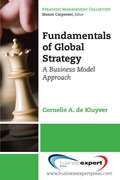Special Collections
Free Upskilling Books for All!
- Table View
- List View
Fundamentals of Global Strategy
by Cornelis A. de KluyverThis book looks at the opportunities and risks associated with staking out a global competitive presence and introduces the fundamentals of global strategic thinking. We define crafting a global strategy in terms of change: how a company should change and adapt its core (domestic) business model to achieve a competitive advantage as it expands globally. The conceptual framework behind this definition has three fundamental building blocks: a company's core business model, the various strategic decisions a company needs to make as it globalizes its operations, and a range of globalization strategies for creating a global competitive advantage. A business model is defined in terms of four principal components: (a) market participation--who its customers are, how it reaches them and relates to them; (b) the value proposition--what a company offers its customers; (c) the supply chain infrastructure--with what resources, activities and partners it creates its offerings; and finally, (d) its management model--how it organizes and coordinates its operations. Globalization requires a company to make strategic decisions about each component of the business model. Market participation decisions include choosing which specific markets or segments to serve, domestically or abroad; what methods of distribution to use to reach target customers; and how to promote and advertise the value proposition. Globalization decisions about the value proposition touch the full range of tangible and intangible benefits a company provides to its customers (stakeholders). Decisions about a company's value chain infrastructure deal with such questions as, What key internal resources and capabilities has the company created to support the chosen value proposition and target markets? What partner network has it assembled to support the business model? How are these activities organized into an overall, coherent value creation and delivery model? Finally, strategic decisions about the global management dimension are concerned with a company's choices about a suitable global organizational structure and decision-making process. We use Pankaj Ghemawat's well-known "AAA Triangle" framework to define three generic approaches to global value creation. Adaptation strategies seek to increase revenues and market share by tailoring one or more components of a company's business model to suit local requirements or preferences. Aggregation strategies focus on achieving economies of scale or scope by creating regional or global efficiencies; they typically involve standardizing a significant portion of the value proposition and grouping together development and production processes. Arbitrage is about exploiting economic or other differences between national or regional markets, usually by locating separate parts of the supply chain in different places.
Intermediate Algebra
by John ReddenIt is essential to lay a solid foundation in mathematics if a student is to be competitive in today's global market. The importance of algebra, in particular, cannot be overstated, as it is the basis of all mathematical modeling used in applications found in all disciplines. Traditionally, the study of algebra is separated into a two parts, Elementary and Intermediate Algebra. This textbook by John Redden, Intermediate Algebra, is the second part. Written in a clear and concise manner, it carefully builds on the basics learned in Elementary Algebra and introduces the more advanced topics required for further study in applications found in most disciplines. Used as a standalone textbook, Intermediate Algebra offers plenty of review as well as something new to engage the student in each chapter. Written as a blend of the traditional and graphical approaches to the subject, this textbook introduces functions early and stresses the geometry behind the algebra. While CAS independent, a standard scientific calculator will be required and further research using technology is encouraged.
Introduction to Psychology
by Charles StangorWhen you teach Introduction to Psychology, do you find it difficult — much harder than teaching classes in statistics or research methods? Do you easily give a lecture on the sympathetic nervous system, a lecture on Piaget, and a lecture on social cognition, but struggle with linking these topics together for the student? Do you feel like you are presenting a laundry list of research findings rather than an integrated set of principles and knowledge? Have you wondered how to ensure your course is relevant to your students? If so, then you have something in common with Charles Stangor. Charles Stangor's Introduction to Psychology utilizes the dual theme of behavior and empiricism to make psychology relevant to intro students. Charles wrote this book to help students organize their thinking about psychology at a conceptual level. Five or ten years from now, he does not expect his students to remember the details of most of what he teaches them.
U. S. History
by OpenStaxThis textbook has been created with several goals in mind: accessibility, customization, and student engagement-all while encouraging students toward high levels of academic scholarship. Instructors and students alike will find that this textbook offers a strong foundation in U.S. history in an accessible format. About U.S. History U.S. History has been developed to meet the scope and sequence of most introductory U.S. History courses. At the same time, the book includes a number of innovative features designed to enhance student learning. Instructors can also customize the book, adapting it to the approach that works best in their classroom.
CK-12 Geometry
by Ck-12 FoundationCK-12 Foundation's Geometry FlexBook covers the following chapters: Basics of Geometry - undefined terms, defined terms, basic postulates of points, lines and planes; distances on a coordinate grid; complementary and supplementary angles; vertical angles; linear pairs and classification of polygons. Reasoning and Proof - inductive reasoning, deductive reasoning, conditional statements, properties of equality and two-column proofs. Parallel and Perpendicular Lines - the parallel line postulate, the perpendicular line postulate, and angles formed by two parallel lines and a non-perpendicular transversal. Congruent Triangles - the Triangle Sum theorem, triangle congruence, the SSS and ASA postulates, the AAS congruence theorem, two-column and flow proofs, the HL congruence theorem, AAA and SSA relationships, isosceles and equilateral triangles. Relationships Within Triangles - the midsegment theorem, the perpendicular bisector theorem, the angle bisector theorem, the concurrency of medians theorem, Napoleon's theorem, and the triangle inequality theorems. Quadrilaterals - interior angles of convex quadrilaterals, classifying quadrilaterals, properties of parallelograms, properties of rhombi, rectangles and squares, and properties of trapezoids. Similarity - ratio and proportion, properties of similar polygons, AAA and AA rules for similar triangles, using SSS and SAS to solve problems about similar triangles, identifying proportional segments in triangles and similarity transformations. Right Triangle Trigonometry - using the Pythagorean theorem when working with right triangles, classification of triangles, the converse of the Pythagorean theorem, using the geometric mean, properties of special right triangles, and trigonometric ratios. Circles - relationships between congruent and similar circles, the equation of a circle, tangent lines, arc measures, chords, inscribed angles, and angles formed by chords, secants and tangents. Perimeter and Area - finding the area of polygons, using scale drawings or models, finding the circumference of a circle, areas of circles and sectors, calculating the areas and perimeters of regular polygons and geometric probability. Transformations - transformations of figures in two-dimensional space including translations, reflections, rotations and dilations.
A Primer on Corporate Governance
by Cornelis A. de KluyverThis book is a primer on corporate governance--the system that defines the distribution of rights and responsibilities among different participants in the corporation, such as the board, managers, shareholders, and other stakeholders, and spells out the rules and procedures for making decisions on corporate affairs. Corporate governance also deals with how a company's objectives are set and the means of attaining those objectives and monitoring performance. The importance of this subject can hardly be overstated. As recent corporate scandals have shown and the current financial crisis reminds us, the efficacy of corporate decision making and our regulatory systems directly affect our well-being. Sound corporate governance not only pays by producing value for all stakeholders of the firm but also, even more importantly, it is the right thing to do--for investors, other stakeholders, and society at large. In other words, sound corporate governance is also a moral imperative. This book is designed to help you become a more effective participant in the corporate governance system--as an executive dealing with a board, as a director, or as a representative of a company's other numerous stakeholders. The book contains two major parts, an epilogue, and appendices. The first part looks at corporate governance from a macro perspective. It describes the U.S. corporate governance system and its principal actors and briefly surveys the history of U.S. corporate governance, including the wave of governance scandals that occurred around the turn of the century. The second part focuses on the board itself and its principal challenges: CEO selection and succession planning, the board's responsibilities in the areas of oversight, compliance and risk management, the board's role in strategy development, the issue of CEO performance appraisal and executive compensation, a board's challenges in dealing with unexpected events and crises, and finally, a board's most difficult challenge--managing itself. The epilogue briefly looks into the future and deals with subjects that are just beginning to appear on boardroom agendas. It assesses the emerging global convergence of governance systems, requirements, and practices; it looks at the prospects of further U.S. governance reform; and it discusses the changing relationship between business and society and its likely impact in the boardroom.
Business Communication for Success
by Scott McleanThis book is suited for Business Communication courses, but is also appropriate for Business English, Business Presentation, Professional Communication courses. Scott McLean brings his authoring expertise to this new communications textbook. Scott has authored textbooks in the areas of Speech Communication, Interpersonal Communication and Public Speaking. Business Communications for Success benefits from Scott's extensive understanding of how students learn the art of effective communication. Students are provided ample opportunity to engage with the concepts, vocabulary and models covered in the text, including role-playing exercises, journal writings, case studies, small-group activities, games, and self-assessment activities.
Business Law and the Legal Environment
by Jethro K. Lieberman and Don Mayer and Daniel M. Warner and George J. SiedelMayer, Warner, Siedel and Lieberman's Business Law and the Legal Environment is an up-to-date textbook with comprehensive coverage of legal and regulatory issues — and organized to permit instructors to tailor the materials to their particular approach. The authors take special care to engage students by relating law to everyday events with which they are already familiar with their clear, concise and readable style. Business Law and the Legal Environment provides students with context and essential concepts across the entire range of legal issues with which managers and business executives must grapple. The texts provide the vocabulary and legal acumen necessary for business people to talk in an educated way to their customers, employees, suppliers, government officials — and to their own lawyers.
Introductory Statistics
by Douglas S. Shafer and Zhiyi ZhangIn many introductory level courses today, teachers are challenged with the task of fitting in all of the core concepts of the course in a limited period of time. The Introductory Statistics teacher is no stranger to this challenge. To add to the difficulty, many textbooks contain an overabundance of material, which not only results in the need for further streamlining, but also in intimidated students. Shafer and Zhang wrote Introductory Statistics by using their vast teaching experience to present a complete look at introductory statistics topics while keeping in mind a realistic expectation with respect to course duration and students' maturity level. Over time the core content of this course has developed into a well-defined body of material that is substantial for a one-semester course. Shafer and Zhang believe that the students in this course are best served by a focus on that core material and not by an exposure to a plethora of peripheral topics. Therefore in writing Introduction to Statistics they have sought to present only the core concepts and use a wide-ranging set of exercises for each concept to drive comprehension. As a result Introduction to Statistics is a smaller and less intimidating textbook that trades some extended and unnecessary topics for a better-focused presentation of the central material.
Launch! Advertising and Promotion in Real Time
by Michael Solomon and Lisa Duke Cornell and Amit NizanLaunch! is written for advertising and promotions courses taught to students in the business school and journalism & mass communication students. This book is the first of its kind to teach advertising concepts by reverse engineering a real advertising campaign from beginning to end. In April 2007, SS+K, an innovative New York City communications agency, launched the first ever branding campaign for msnbc.com with the tag "A Fuller Spectrum of News." Launch! follows that campaign from initial agency pitch through roll-out of print and media assets to post-campaign analysis. Throughout, it exposes readers to the theory and concepts of advertising and promotion, and the personalities and decisions that drove this campaign. The book takes a rare look "behind the curtain" - even letting you see some of the paths not chosen by the agency and client. Students get a realistic sense of how theory plays out in practice. They get a flavor for the exciting field of advertising. And, they consistently learn the perspectives of both the advertising agency (where many journalism and communications students will work) and the client (where many marketing majors will work). This is a unique book, with a unique perspective, by a unique author team, and you won't find this kind of insight in any other text on the market.
Law of Commercial Transactions
by Jethro K. Lieberman and Don Mayer and Daniel M. Warner and George J. SiedelMayer, Warner, Siedel and Lieberman's Law of Commercial Transactions is an up-to-date textbook that covers legal issues that students who engage in commercial transactions must understand. The text is organized to permit instructors to tailor the materials to their particular approach. The authors take special care to engage students by relating law to everyday events with their clear, concise and readable style.
Legal Aspects of Marketing and Sales
by Jethro K. Lieberman and Don Mayer and Daniel M. Warner and George J. SiedelMayer, Warner, Siedel and Lieberman's Legal Aspects of Marketing and Sales is an up-to-date textbook that covers legal issues that students who will work in marketing or with marketing managers must understand. The text is organized to permit instructors to tailor the materials to their particular approach. The authors take special care to engage students by relating law to everyday events with their clear, concise and readable style.
Mastering Public Relations
by Shannon A. Bowen and Brad Rawlins and Thomas MartinThis book provides an executive review of the field of public relations with a focus on what managers need to know in order to master the function quickly and effectively. Throughout the text, we integrate the academic with the professional by asking, how can an executive use this knowledge to make the most of the public relations function, department, and initiatives in order to help their whole organization be successful? , , , and of the book provide the busy manager with the taxonomy of the public relations field, provide research on the theory of public relations, and examine the structure of organizations and where public relations fits within that structure. , , , and examine how public relations should be conducted in order to achieve maximum results and provide a comprehensive review of public relations strategy, including how to conduct a public relations campaign. , , , and discuss the organizational settings most common in public relations: corporate, agency, government, or public affairs and nonprofit or advocacy groups and the public relations approaches common in each. We review what research finds regarding the most excellent ways to manage public relations and the best ways to analyze and address the ethical challenges to be faced in public relations. We occasionally use short case examples to illustrate and apply the main points managers will need to know in order to manage public relations effectively. Throughout this book, we focus on the managerial pursuits in public relations, such as strategic relationship maintenance, segmentation of publics, and conducting research. We offer insight into the managerial activities of issues management, lobbying and advocacy, creating stakeholder relationships, reputation management, ethical counsel, and corporate communication. We examine the most current thought in public relations to help the busy manager master the most important concepts in the field quickly, accessibly, and with an eye toward helping an organization or client achieve the most effective results through cutting-edge, modern, research-based strategic public relations management.
Anatomy & Physiology
by OpenStaxHuman Anatomy and Physiology is designed for the two-semester anatomy and physiology course taken by life science and allied health students. The textbook follows the scope and sequence of most Human Anatomy and Physiology courses, and its coverage and organization were informed by hundreds of instructors who teach the course. Instructors can customize the book, adapting it to the approach that works best in their classroom. The artwork for this textbook is aimed focusing student learning through a powerful blend of traditional depictions and instructional innovations. Color is used sparingly, to emphasize the most important aspects of any given illustration. Significant use of micrographs from the University of Michigan complement the illustrations, and provide the students with a meaningful alternate depiction of each concept. Finally, enrichment elements provide relevance and deeper context for students, particularly in the areas of health, disease, and information relevant to their intended careers.
CK-12 Life Science
by Ck-12 FoundationCK-12 Foundation's Life Science FlexBook Covers the following chapters:Studying Life- Nature of science: scientific method. tools used in science and safety in research. Introduction to Living Organisms- what they are, what they are made of, and classification. Introduces carbs, lipids, proteins, and nucleic acids. Cells and Their Structures- what they are, what they are made of, organelles and eukaryotic vs. prokaryotic. Cell Functions- ctive transport, passive transport, photosynthesis, and cellular respirationCell Division, Reproduction, and DNA- mitosis, meiosis, DNA, RNA, and protein synthesisGenetics- Mendel's peas to gene therapy. Evolution- Darwin's natural selection, history of life and evidence of evolution. Prokaryotes- properties and characteristicsProtists and Fungi- properties, characteristics, reproduction and metabolismPlants- nonvascular & vascular, gymnosperms & amniosperms and hormones/tropismsIntroduction to Invertebrates- sponges, cnidarians, and wormsOther Invertebrates- mollusks, echinoderms, arthropods, and insectsFishes, Amphibians, and Reptiles- fishes, amphibians, and reptilesBirds and Mammals- characteristics, properties, diversity and significanceBehavior of Animals- communication, cooperation, mating and cyclesSkin, Bones, and Muscles- skeletal, muscular and integumentary systemsFood and the Digestive System- nutrition and digestionCardiovascular System- heart, blood, vessels and cardiovascular healthRespiratory and Excratory Systems- breathing and elimination of wasteControlling the Body- Nervous SystemDiseases and the Body's Defenses- Diseases and the immune responseReproductive System and Life Stages- Reproduction, fertilization, development and healthFrom Populations to the Biosphere- Ecology: Communities, ecosystems, biotic vs. abiotic factors, and biomesEcosystem Dynamics- Flow of energy, recyclig of matter, and ecosystem changeEnvironmental Problems- Pollution, renewable vs nonrenewable resources, habitat destruction & extinction, and biodiversity
CK-12 Advanced Probability and Statistics Second Edition Volume 2
by Ck-12 FoundationAn open source textbook.
Advanced Business Law and the Legal Environment
by Jethro K. Lieberman and Don Mayer and Daniel M. Warner and George J. SiedelMayer, Warner, Siedel and Lieberman's Advanced Business Law and the Legal Environment is an up-to-date textbook with coverage of legal and regulatory issues that are more technical than the topics in the authors' Foundations of Business Law and the Legal Environment. Appropriate for students who have already taken an introductory Legal Environment or Business Law course, the text is organized to permit instructors to tailor the materials to their particular approach. The authors take special care to engage students by relating law to everyday events with which they are already familiar with their clear, concise and readable style. Advanced Business Law and the Legal Environment provides students with context and essential legal concepts relating to the Uniform Commercial Code and various aspects of property law. The text provides the vocabulary and legal savvy necessary for business people to talk in an educated way to their customers, employees, suppliers, and other stakeholders -- and to their own lawyers. With Advanced Business Law and the Legal Environment, the authors have created a text that not only has both case summaries and excerpted cases, but one that you can easily customize by deleting chapters, reordering the content, adding your own material, and even editing at the line level with Flat World's easy-to-use MIYO (Make It Your Own) Platform.
Building Strategy and Performance
by Kim WarrenThe fundamental challenge facing business leaders is to drive performance into the future--the dynamics of strategy. To tackle this effectively, they need a clear understanding of what causes performance to improve or deteriorate and what power they have to change this trajectory for the better. Without this understanding, they risk making poor choices about their future--failing to exploit promising opportunities, pursuing unachievable aims, or falling victim to competitive and other threats. Building Strategy and Performance Through Time sets the agenda for building business strategy in powerful, actionable, and accessible terms. It gives executives clear frameworks for answering three fundamental questions: * Why is our business performance following its current path? * Where is it going if we carry on as we are? * How can we design a robust strategy to transform this future? The existing strategy tools most widely used help guide management's choices about where to compete--which customers to serve, with what products and services, and how to deliver those products and services to those customers effectively and profitably. While this choice is important, it is not often changed in any fundamental way; having found a reasonably strong and profitable position on these issues, few firms will, or should, set off in a new direction. But there is still much to be done to deliver that strategy, powerfully and sustainably over time. Many decisions need to be made, continually and holistically, across all functions of the business and adapted as conditions change from month to month and year to year. Pricing, product development, marketing, hiring, service levels, and other decisions cannot be made in isolation but must take into account other choices being made, elsewhere and at different times. Building Strategy and Performance Through Time explains a reliable, practical method, known as strategy dynamics, that creates a living picture of how an enterprise actually works and delivers performance. This picture shows exactly where the levers are that management controls and how to choose what to do, when, and how much, to accomplish your specific goals. It shows, too, how the same approach can be used to defeat competitors, cope with other outside forces, and keep delivering performance.








